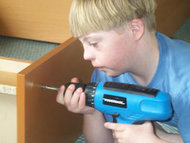Downs Syndrome
Down Syndrome encompasses a number of chromosomal differences, of which trisomy 21 (an aneuploid) is the most common, causing highly variable degrees of learning difficulties as well as physical disabilities. It is named for John Langdon Down, the British doctor who first described it in 1866. While Down Syndrome is the medically recognized term in the US, some support groups and organizations use Down's Syndrome. more...
Overview
Down Syndrome is a naturally occurring chromosomal irregularity. The sole characteristic shared by all persons with Down Syndrome is the presence of extra genetic material associated with the 21st chromosome. The effects of that extra genetic material varies greatly from individual to individual 5, depending on the extent of the extra material, genetic background, environmental factors, and random chance.
The incidence of Down Syndrome is estimated at 1 per 800 births, making it the most common human aneuploid. The maternal age effect influences the chance of conceiving a baby with the syndrome. At age 20 to 24, it is 1/1490, while at age 40 it is 1/106, and at age 49 is 1/11. (Hook EB., 1981). Genetic counseling and genetic testing such as amniocentesis are usually offered to families who may have an increased chance of having a child with Down Syndrome. Many children with Down Syndrome are born to women under the age of 35, mainly because that is the prime reproductive ages for women.
The term 'Down Syndrome' was first used in 1961 by the editor of The Lancet 2. It was originally called mongolism or mongolian idiocy, after a perceived resemblance observed by John Langdon Down between the faces of some of his patients with Down Syndrome and the Mongoloid race. This usage is now viewed by medical professionals as offensive and medically meaningless, and is not commonly used today. Professor Jérome Lejeune proved in 1959 that Down Syndrome is a chromosomal irregularity.
While most children with Down Syndrome have a lower than average cognitive function, some have earned college degrees with accommodations, and nearly all will learn to read, write and do simple math. The common clinical features of Down Syndrome include any of a number of features that also appear in people with a standard set of chromosomes. They include a "simian crease" - a single crease across one or both palms, almond shaped eyes, shorter limbs, heart and/or gastroesophageal defects, speech impairment, and perhaps a higher than average risk of incidence of Hirschsprung's disease. Young children with Down Syndrome are also more prone to recurrent ear infections and obstructive sleep apnea.
Early educational intervention, screening for common problems such as thyroid functioning, medical treatment where indicated, a conducive family environment, vocational training, etc., can improve the overall development of children with Down Syndrome. On the one hand, Down Syndrome shows that some genetic limitations can not be overcome; on the other, it shows that education can produce excellent progress whatever the starting point. The commitment of parents, teachers and therapists, to individual children, has produced previously unexpected positive results.
Read more at Wikipedia.org



